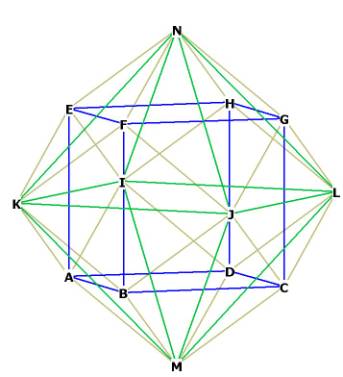|
(2019
midterm assignment) Model Midterm answers 2019 (Index) Essay 3: Web Highlights |
 |
Christopher Carlson
March 28, 2019
To see or not to see: A look to
the past to brighten our future
The whole purpose of writing is to
express the thoughts one possesses that he/she wishes to convey in a field
without ambiguity. When we look at others’ writing, we see not only the flaws
and strengths within theirs, but also those that exist within our own works.
Within this short work, I plan on doing just that. I will examine the midterms
constructed by previous classes and point out why I liked them and what it makes
me want to do in my own future work. The essays I examine helped me see my flaws
with brevity, being narrow-minded about how much I knew about a topic, and my
lack of insight and voice that often exists in my own work.
I will start out by examining the part one essay.
This class has shown us that literature
of the future can have an evolutionary, creation/apocalypse, or alternative
future setting in mind. The purpose of part one is to simply explain these
concepts effectively and prove mastery of the topic as a whole. One such article
that I felt did just that was Katie Morin’s work. She quotes that, “However,
apart from these more obvious signs of evolution, the short story also features
less obvious signs of evolution, such as the protagonist’s hesitancy to upgrade
to radial tires, which is reiterated time and time again, presumably to
emphasize the changing times.” I love this piece of insight, because even though
I read Bears Discover Fire a couple
of times, since I found the premise and its characters pretty humorous, I never
picked up on this personally. This was what interested me about this piece. The
author also had relatively brief paragraphs but was able to express a great deal
in each, as well as conveying relatively unnoticed pieces of insight about texts
in most of them.
Katie’s essay did another intriguing feature by
referencing past students’ work to help validate her point. I liked this idea of
utilizing the work of your peers almost like scholarly articles. It all together
gives the essay better flow and makes the testimony seem more believable, since
others agree with one’s claim. I learned from this particular essay that brevity
in one’s paragraphs will allow one the ability to not overwhelm the readers, but
still have the ability to present effective insight into texts as long as the
right words are used. This has always been an issue of mine, but this text has
reminded me to speak less and you can often convey more. Speaking of learning
something that I often struggle with, I learned a great deal about how to
improve my research topic from the part two essay I selected.
I have always possessed a passion for
the idea of artificial intelligence and its ability to replicate the nature of
humans with greater effectiveness as time progresses. My research essay looks at
a similar idea, but rather how mankind and AI are both transforming and at what
point do they become the other, when does AI become human and vice versa. This
was why I instantly gravitated towards the essay entitled
Artificial Extinction. Upon reading
Tanner’s work, I found many excellent strategies he took advantage of that I
wish would have come to my mind. One such instance is when he states, “At the
rate at which machines learn and artificial intelligences advance, human
intelligence and innovation will obsolete within a hundred years. Billions of
years of evolutionary progress are leading humanity down a path in which it
becomes so powerful that it becomes the master of evolution.” While I mentioned
the idea of artificial augmentation being a sort of next stage in human
evolution, I never thought about bringing up the idea of technology giving us
the means to bring about change in ourselves and others at will. I guess when
you think about how a robot evolves, from hand, to arm, to full robot, to
intelligent AI, we are already a master of evolving the machines. I find it kind
of ironic but cool that the machines we are developing could be the one’s that
help develop us. This was a kick ass idea that I really wish I had thought about
in my own work.
Tanner also reminded me of the term ‘transhuman,’ which
would have been a perfect addition to my work. In an essay entirely about
mankind potentially losing its humanity to the machines, it would have been
intriguing to have talked about it more like we are transcending humans and
evolving past the more primitive state. It is very likely that because of this
work, I will consider citing this and using it to explain the progress of AI and
man together, how they help each other develop. This essay has reminded me that
even with topics and ideas that you feel you have mastered, it always pays to
look at the work of others, since new ideas and terminology can assist in
developing into an even better writer. Through looking at Tanner’s work, I
gained insight into means to evolve my own research essay into a more perfected
paper. Going off of this idea of evolving, the third work I examined also
presented effective means for my improving as a writer.
When I first saw what the purpose of
part three was, I thought to myself, why are we really doing this? It seemed a
bit alien compared to many of the other reviews I have done, most of them being
of experts on a topic. The work of Clark Omo provided the exact answer I was
searching for. He states, “I agree with both Britt’s and Morrow’s analyses of
the story’s they chose, and I now have reinforcement for my own selected pieces
from the class itinerary provided so far.” The way he constructs his work is to
effectively explain his choosing these articles and what he learned from reading
their own analyses. While some of us are not yet science fiction and speculative
fiction aficionados, reading ideas of others that correspond with our own
provide us with a feeling of confidence that we need to continue onward with our
own research and ideas. In addition to making the point of part three known to
me, Clark did many other things that drew me towards his essay. To start, I
liked how Clark split up his paragraphs from analyzing the work of one then
moving on to another and then comparing the two works to each other. By
separating it as such, it provides clear insight to the reader in a short
package. Since his paragraphs are not long, the reader can better ingest the
meanings and not feel lost in verbiage. Lastly, Clark did an exquisite job of
implementing his own ideas in an essay that could easily become overrun with the
ideas of others. By making his claims clear and distinctive, the reader
understands that Clark is a trustworthy source worthy of evaluating.
In summation, a variety of perceptions opens new doors of thought for the people that read them. By being exposed to these exceedingly different essays, I was able to learn what notions are deemed worthy of praise and evaluate my own personal writer for these skills. I can feel good about myself when my ideas align with my peers, as well as learning new ideas that I can implement in future works. This work was as much a self-evaluation as it was a critique of my peers’ writings, and I hope I can utilize my own insight effectively in my future works for not only this class, but all writing pieces I will create.
 |
 |
 |
